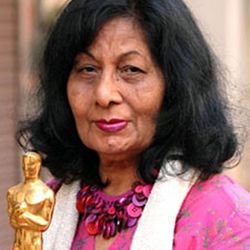I have just returned from an important exhibition in Goa. ‘Bharat Through The Lens of Bhanu Athaiya’ is among the first exhibitions put together by Prinseps auction house, at Goa’s Aguada Jail Museum, a gorgeous little fort and deck which has now turned into a chic hangout space.
I have long admired Athaiya. She was well known as India’s original costume designer, with a career spanning six decades. She worked with filmmakers ranging from Guru Dutt and B.R. Chopra to Yash Chopra, Vijay Anand and right down to Ashutosh Gowarikar. She brought home India’s first Oscar, for Richard Attenborough’s film Gandhi, where she styled the entire film in authentic handlooms. She was also a fine arts graduate from Sir JJ School of Art in Mumbai, and became the only woman to be a part of the Bombay Progressive Artists cabal, which included India’s first modernists like M.F. Husain, F.N. Souza and S.H. Raza.
But like most of my generation, I only began to realise her genius in her late years. Athaiya died in 2020 at the age of 91. At the time, she lived in the old area of Colaba, Mumbai, forgotten by the pomp and glamour that the Bollywood film industry now is. This is the curse of social media and the internet—if your best work has preceded it, it is almost as if it did not exist. History, as we know it, is learned from books, museums and legacy. Athaiya’s legacy was not documented either.
Much of what we are learning now is thanks to Prinseps and its founder Indrajit Chatterjee. Credit is also due to the sparkling young curator and conservator Brijeshwari Kumari Gohil, an art history and heritage graduate and descendent of the former royal family of Bhavnagar. The Prinseps team had bought Athaiya’s estate—much of it stored in trunks and cupboards in a garage in Colaba—from Athaiya’s daughter, Radhika Gupta. They began to piece together Athaiya’s life and work through their finds.
Through the showcase, I realised how Athaiya’s childhood shaped her and how important it was for young women to have liberal parents. She was born as Bhanu Rajopadhye in pre-Independence India. Her hometown was the centre of local and western political and cultural influences. Its original name was Kalapur, or the city of arts. Painting, photography and cinema flourished there. Athaiya’s father had gifted his wife a Singer sewing machine, which Athaiya inherited. The sewing machine is part of the exhibition, as are some of Athaiya’s artworks.
There are also prototypes of Athaiya’s costumes for famous films like Vyjayanthimala’s costume in Amrapali, Salma Agha’s joda in Nikaah, and many of Zeenat Aman’s costumes. The iconic Aman is here for the opening of the show, acknowledging the role Athaiya and her costumes played in her pioneering career. Athaiya famously had a mannequin made to Aman’s proportions in her studio, so the movie star would not have to come in for multiple trials.
“Suddenly there was this good bad girl, or the bad good girl”, Aman tells me at the show. “Producers started writing scripts for me in that way…. In Hare Rama Hare Krishna and Heera Panna, I was a drug addict and a jewel thief…. In Roti Kapada Aur Makaan, I dump the poor guy for the rich guy. Producers wrote roles for me that had shades of grey, we broke the demarcation of the vamp and the Madonna….”
Aman credits Athaiya for always taking the heroine’s comfort into account in a sexy costume, something only a woman could do.


